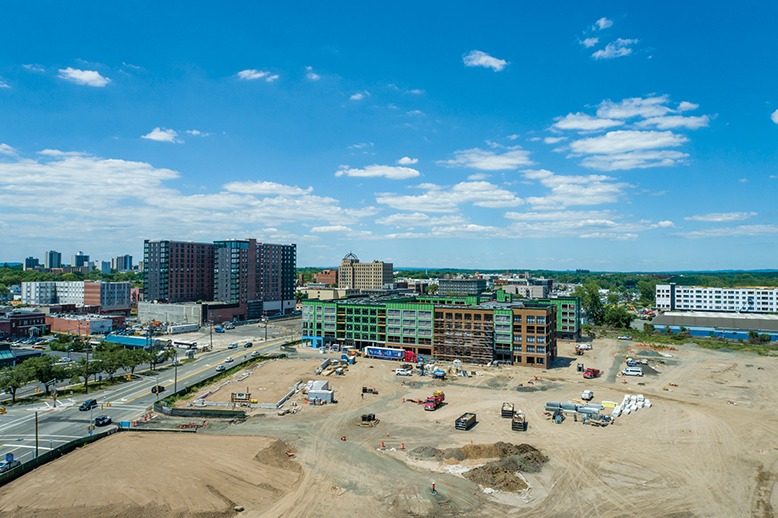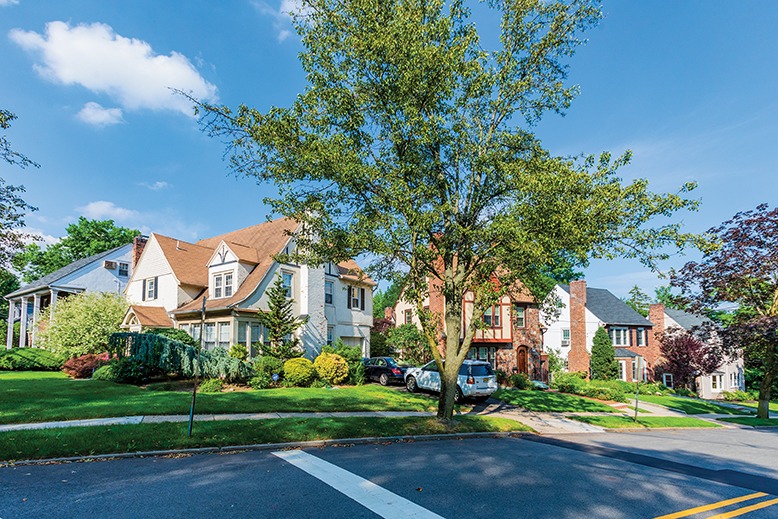
Forgive Hackensack for feeling overlooked. Torched by the British during the Revolution, the Bergen County seat never flexed the industrial muscle of Paterson, boasted the cultural richness of Newark, or enjoyed the cachet of Montclair. Instead, the city on its namesake river became known as a shopping destination. Its Main Street was the place to buy a dress or a suit. You could also catch a matinee at the Fox or the Oritani.
But the advent of malls—specifically, those in Paramus—spawned a decades-long decline of Hackenack’s urban core. The Franklin Simon and Arnold Constable department stores? Gone. The downtown movie theaters? Gone. The beloved Prozy’s Army-Navy store? A memory. Billy Joel didn’t help by singing, “Who needs a house out in Hackensack? Is that all you get for your money?”—lyrics that dissed a city gone dowdy.
Nowadays, Hackensack is feeling better about itself. A downtown revitalization in recent years has spawned a construction boom hitched to an eyebrow-raising nickname: the Sack.
Enticed by financial incentives from the city, developers are replacing underused or vacant commercial properties, even a parking lot, with luxury rental buildings replete with the amenities young professionals covet: gyms, swimming pools, grilling stations, pet spas, and rooftop decks with Manhattan views. The new buildings—some occupied, others under construction or yet to break ground—comprise more than 3,500 studio, one- and two-bedroom apartments, which could push the city’s population to 50,000 by 2024. (Currently at 43,856, Hackensack is New Jersey’s 20th most populous municipality.)
“For years, downtown Hackensack sat here, and nothing was happening,” says Bryan Hekemian, chairman of the Main Street Business Alliance, the public-private partnership that is central to the city’s redevelopment. “Well, now it’s Hackensack’s turn. Not just turn, but time.”
The family enterprise, Hekemian & Co., where Hekemian is an executive vice president, built one of the first projects available to lease, the Current on River, situated a quick stroll from White Manna, the iconic River Street greasy spoon that has served up sliders for 75 years. Within sight of the Current, two larger, mixed-use projects are underway: the Brick, a 14-story rental building, and the Print House, a 700-unit apartment complex where the Record newspaper once stood.
[RELATED: Intriguing Restaurants in Hackensack]
Among finished buildings, one bears the Woolworth moniker, homage to a long-gone Main Street retailer, and two have addresses for names—22 Sussex and 210 Main. The latter is a repurposed, art-deco bank tower. At 12 stories, it was the tallest building in Bergen County when it opened in 1926.
“We firmly believe Hackenack’s a good bet,” says Mike Pembroke, chief operating officer of Russo Development, one of the companies behind the Print House, along with the Hampshire Companies and Fourth Edition, Inc. He cites assets such as the two train stations, buses to Manhattan, proximity to highways, and the presence of a major hospital, Hackensack University Medical Center.
As the county seat, Hackensack also has Bergen County offices and courts—which means plenty of potential tenants. Hackensack is also home to a Fairleigh Dickinson University campus.
Transportation, medicine, government, education—these same ingredients have helped nurture redevelopment in New Brunswick, Jersey City and other Garden State locales.
Back at the Current, Hekemian says the average tenant age at his company’s 254-unit building, which opened in 2020, is 36. But Albert Dib, the city’s director of development, says Hackensack’s rejuvenation will be a multigenerational phenomenon.
“People keep talking about millennials, and they’re probably the largest segment, but it’s really a cross section,” says Dib. “We’re seeing empty nesters who want to stay near their families and want amenities like a swimming pool and a parking space. There’s a wide spectrum of renters of various demographics and ethnicities.”

Debbie Lopez and boyfriend Ron Chatterjee moved to an apartment at the Current, a quick stroll to popular eateries. Joe Polillio
Hackensack is one of the last places Debbie Lopez, who works for a New York City financial-services firm, thought she would find herself. After spending much of her adult life on the New York side of the Hudson, the 40-year-old Bergen County native took an apartment at the Current with her boyfriend.
Manhattan, says Lopez, “lost its purpose” during the pandemic. While bemoaning the Sack’s lack of a party atmosphere—the limited supply of liquor licenses is a Main Street sore point—Lopez appreciates that she can walk for Colombian or Vietnamese food, or for the crumb cake at B&W, a venerable German bakery. The ethnic diversity reminds her of her former digs in West Harlem.
“I can have my little city life outside the door, but also the calming suburbs nearby,” she says. “It’s the best of both worlds.”
Rents for the new apartments run from nearly $2,000 to more than $3,000 a month. That’s not cheap, but it’s less than comparables in Manhattan or on the New Jersey Gold Coast. Still, at least two of the completed buildings were offering incentives this summer for new tenants. Crossroads 389, an 82-unit building on Main Street, was offering up to three months free with a two-year lease. And 210 Main was providing four months free on a 28-month lease.
***
As the apartments fill up, Hackensack officials are counting on the arrival of new businesses to serve the newcomers. A main objective is the invigoration of Main Street, which this year was returned to two-way traffic. A stretch of Main occupied by Latin delis and bakeries, beauty supply shops, hair and nail salons, dollar stores, and law offices—and empty storefronts—is seeing an uptick in evening activity and some new blood. Farther north, off Main, a couple of microbreweries have taken root; near the courthouse, a Gothic Revival church building has been transformed into a performing arts center. And perhaps there’s no better symbol of where Hackensack might be headed than the rock-climbing gym rising in the vicinity of the Print House and the Brick.
All this has elevated Hackensack’s profile and invited comparisons with another river city—but one with a reputation for hipness. Which begs the question: Is Hackensack the next Hoboken?
“I don’t want us to be Hoboken; I want us to be the new Hackensack,” says John Labrosse, the mayor since 2013. “There’s a much different vibe here. We have a distinct downtown area in a residential city. That’s a big bonus. As people move into our new buildings, a lot of these millennials may decide, after time, to buy a house and raise their families here.”

Hackensack’s downtown construction boom has helped raise values of single-family homes on desirable residential blocks like Summit Avenue. Joe Polillio
The new construction has helped enliven Hackensack’s real estate market, which includes leafy neighborhoods of gracious colonials in the Fairmount section and high-rise condos along Prospect Avenue, near the medical center. From 2017-2020, the median sale price of a single-family home in the city rose 27 percent, to $425,000. Condos and townhouses rose 23 percent, to a median of $225,000, according to the New Jersey Multiple Listing Service.
“Thirty years ago it was like, ‘Eeew, Hackensack,’” says Larry Greenberg, a broker associate at Vikki Healey Properties in neighboring Maywood. “But as a result of all that’s going on, Hackensack has edged into the destination category. It’s gone from being an average town to one people are asking for by name.”
The city may well be “on the rise,” as posters in downtown windows proclaim, but the redevelopment is not universally applauded. Predictably, some fear population growth will bring additional traffic. Rich Cerbo, son of a former mayor and himself a former candidate for local office, calls the new apartments “a risk worth taking,” but wonders if millennials will be sated in a town that—let’s face it—isn’t Manhattan (or Hoboken). “Move to Hackensack, and do what?” he muses. “Get in the car and drive somewhere else?”
[RELATED: New Jersey’s Next Hot Housing Markets]
Then there’s Patricia Carter (not her real name). The retired Garden State Parkway employee grew up in Hackensack, lives next door in Lodi, and would love to move back to her revitalized hometown, where she volunteers in the food pantry at Varick Memorial AME Zion Church, the city’s oldest Black congregation. Browsing the new apartments online, though, she is overcome with sticker shock.
“I’m glad they’re doing something to keep Hackensack alive,” says Carter. “But I’m sad they’re building for people not like me, but for people who can afford it.”
Billy Joel may need to update his opinion of Hackensack—a city he might not recognize today.
Jay Levin is a former reporter for the Record and a contributor to the New York Times real estate section. He lives in Teaneck.



